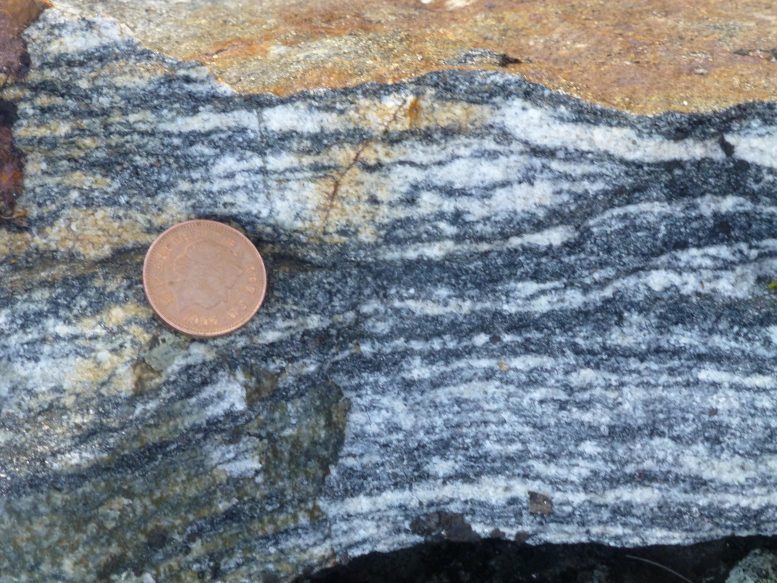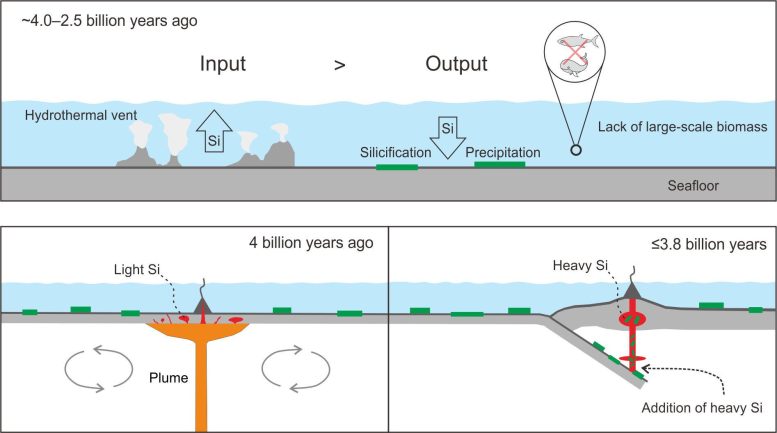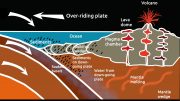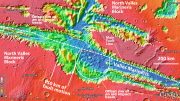
Earth’s oldest rock: 4-billion-year-old granitic rock from Northwest Territories, Canada. Credit: Prof. Li Xianhua’s group
Currently, Earth stands alone as the only identified planet that sustains life, thanks in large part due to the dynamics of plate tectonics. This process plays a pivotal role in recycling vital biogeochemical elements and ensuring the planet’s temperature remains regulated. Subduction—the destructive force of plate tectonics that pushes one plate beneath another—is the most telltale sign of plate tectonics’ great recycling program.
However, how deep into Earth’s past can we find traces of plate tectonics? Have the tectonic plates always operated as they do today, with processes like subduction and surface material recycling?
Previous studies using numerical geodynamic modeling have argued that subduction and recycling were operating from as early as ~4.3 Ga (GA means “giga annum,” which is a unit of time equal to one billion years.) ago. Since Earth itself is only 4.5 Ga old, such a claim argues for plate tectonics from almost day one.
However, new geochemical evidence obtained from Earth’s oldest-known rocks—found in remote lake regions of northern Canada—paints a starkly different picture of Earth’s earliest history.
The study presenting this evidence, which was published in Science Advances on June 30, was conducted by researchers led by Prof. Li Xianhua from the Institute of Geology and Geophysics of the Chinese Academy of Sciences (IGGCAS), in collaboration with colleagues from Australia and Canada as well as China.
“Our oldest samples show no sign of surficial material recycling at 4.0 Ga,” said Prof. LI, co-corresponding author of the study. “And the earliest evidence we find for surface recycling into magmas isn’t until 3.8 Ga.”

At ~ 4.0–2.5 billion years ago, seawater was saturated with Si and the silicified seafloor was rich in heavy Si. The study found a change between 4.0—before heavy Si was incorporated into granitic magma—and 3.8 Ga—when it was incorporated for the first time. Credit: Prof. Li Xianhua’s group
Silicon (Si) and oxygen (O) isotopes in granitic rocks are tracers of surface material recycling in magma. On ancient Earth, seawater was saturated with Si and rich in heavy Si due to the lack of lifeforms to consume it. Thus, if any heavy Si materials from the seafloor were recycled back into magma chambers by subduction, then heavy Si isotopes would be detected in granitic rock samples.
“One of the difficulties in applying this technique to ancient rocks is identifying the primary Si isotope composition. This is because these rocks have been reworked by heat and pressure repeatedly throughout Earth’s long history,” said ZHANG Qing from IGGCAS, lead author of the study.
Zircon, the most abundant datable mineral in granitic rocks, is also conveniently resistant to weathering and later alteration. Applying ultra-high precision analytical techniques to zircon can provide the most reliable constraints on whether the detected Si isotope composition represents the primary signature.
“[The researchers’] study proposed systematic screening criteria for evaluating the data. I must commend them on their careful evaluation of their zircon Si and O isotope data,” said an anonymous reviewer of the paper.
The absence of a heavy Si signature in the 4.0 Ga rocks means the oldest samples didn’t require subduction.
“Nonetheless, given that the oldest rocks are from a single locality, no subduction needed for one small area doesn’t mean no plate subduction on the planet at 4.0 Ga,” said co-author Allen Nutman from Australia’s University of Wollongong.
After careful filtering, though, the data revealed a distinct shift at 3.8 Ga in both Si and O isotopes. For this reason, based on current data, the study concludes that a possible change in Earth’s geodynamics, such as the onset of plate subduction, occurred at 3.8 Ga.
“It was already amazing that these oldest rocks are preserved,” said co-author Ross Mitchell from IGGCAS, “and now we learn that they also tell a tectonic coming-of-age story as well.”
Reference: “No evidence of supracrustal recycling in Si-O isotopes of Earth’s oldest rocks 4 Ga ago” by Qing Zhang, Lei Zhao, Dawn Zhou, Allen P. Nutman, Ross N. Mitchell, Yu Liu, Qiu-Li Li, Hui-Min Yu, Billy Fan, Christopher J. Spencer and Xian-Hua Li, 30 June 2023, Science Advances.
DOI: 10.1126/sciadv.adf0693









Be the first to comment on "4 Billion Years Old – Earth’s Oldest-Known Rocks Provide Clues About Early Tectonics"